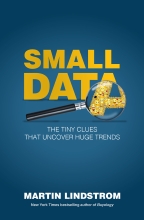- Categories:
A Scary Secret About Amazon
 By Martin Lindstrom
By Martin Lindstrom
Author of the forthcoming book Small Data: The Tiny Clues That Uncover Huge Trends (St. Martin’s) and 2016 Winter Institute keynote speaker
Amazon’s recent opening of an old-fashioned, brick-and-mortar bookstore couldn’t be more ironic. Is this a PR stunt? A shrewd attempt to present a human image in the wake of recent reports (by the New York Times and others) about its all-consuming corporate culture? Or does it perhaps know something the rest of us don’t?
Given that Amazon has become the poster boy for tech monopolism — and the faceless, virtual Goliath of retailers — the announcement set off plenty of online smirking, and it’s hard not to enjoy it. But let’s also seriously consider this question: Why is Amazon doing this?
The answer may tell you a lot about the future of your own store and, most importantly, what you should be focusing on.
Trust me, Amazon isn’t entering the physical world without having done its research. It has spent millions on discovering those crucial things at which an online merchant can’t excel. The most important of these is sensory exploration.
Did you know that 83 percent of all brand and retail communication in today’s world only appeals to the sense of sight? This leaves just 17 percent to our four other senses: touch, taste, sound, and smell.
 In preparation for my ABA speech this January, I decided to tap into the technique I detail in my forthcoming book, Small Data:The Tiny Clues That Uncover Huge Trends (St. Martin’s). The book’s premise is simple: By observing consumers in their home environments, you’ll be able to pick up seemingly insignificant clues that, time after time, reveal surprising insights about consumers and their true needs. As part of my study, I visited bookstores across the country. My intention was to understand the things that truly affect a book buyer’s decision.
In preparation for my ABA speech this January, I decided to tap into the technique I detail in my forthcoming book, Small Data:The Tiny Clues That Uncover Huge Trends (St. Martin’s). The book’s premise is simple: By observing consumers in their home environments, you’ll be able to pick up seemingly insignificant clues that, time after time, reveal surprising insights about consumers and their true needs. As part of my study, I visited bookstores across the country. My intention was to understand the things that truly affect a book buyer’s decision.
Surprisingly, my Small Data study revealed that only 41 percent of our book-buying choices rely on the sense of sight! Perhaps even more surprising, an astounding 31 percent of all book sales rely on the sense of touch, and another 23 percent rely on the sense of smell.
These Small Data observations, combining total consumer experience independent of channel, may reveal why Amazon has decided to enter the brick-and-mortar battleground. Amazon realizes it has hit — or will soon — the ceiling of potential online book sales. Its next battleground? To capture and utilize the power of our other senses.
Every consumer possesses assets that everyone in retail desires to capture — the senses. Think about it. Would you hire a new staff member on the basis of an e-mail correspondence only (using just the sense of sight)? Would you rely on a phone call only (using just the sense of sound)? Or even a Skype call (relying on two senses)? I’ll bet you’d be reluctant to employ anyone using just these channels, despite the fact that nearly everything material to the job can be communicated using sight and sound. We still prefer a physical interaction with our prospective hire. We want to feel the person’s handshake, get a sense for “vibes” and “chemistry.” We can’t do these things without some face-to-face contact. Indeed, this is the very essence of the battleground for survival in the bookselling universe.
As I travelled across the country, I made it a habit of popping into local bookstores to catch up with the store owners. Time after time, I discovered how the sense of smell directly correlates with sales. “It’s so funny you point out the smell,” one indie bookseller told me as I noted how wonderful it “felt” to be in her bookstore. “Every third customer says the same thing.” Sales in this bookstore, I should point out, were booming.
I’ve learned that touch is often even more important. My work with LEGO over the years has taught me a fascinating insight. Whenever a kid takes a large LEGO box down from the shelves and begins shaking it, the kid is 82 percent likely to buy it. No shake: 40 percent. No touch: no purchase.
This is not surprising, given an experiment I’ve conducted in bookstores. In the first part of the experiment, I asked sales staff to point at a book when recommending it to the customer. In the second part of the experiment, I asked sales staff to offer the book with both hands to the customer and keep holding onto it, while the customer tugs at it, for four or five seconds before letting it go. I call this the “invisible touch.” The salesperson has made physical contact with the customer, and even though the customer doesn’t quite realize it, a bond has been established among the salesperson, the product, and the customer.
The result? Just pointing at the book generated a sale every ninth time, while the second, more physical approach generated a sale every third time.
Even sight, as ordinary as it may seem, is a powerful tool for increasing sales. The Small Data clues I pick up while interacting with customers suggest that we’re all desperate for small moments of transition in our lives. Think about it. The first thing you do when you wake up in the morning is to grab your smart phone. You’re on the phone while eating breakfast. You’re on the phone in the car. When do you allow your brain to “reboot”? Walt Disney was a master at the art of transition, basing all his theme parks on transformations. Have you ever noticed how the pavement in the parks changes, as you walk from theme to theme, subtly transforming your mood?
So, here’s a magic trick to give your customer a feeling of transition. Install what I call ambient or “cozy” light in your store.
For many, books are associated with our rare cozy moments. Picking up a book is the moment we go inside our own heads. We let go of our smart phones, switch off the TV, forget about the fine art of multitasking (which we think we’re able to do). Even our breathing changes, and our muscles relax. We indulge ourselves in a world of escape, exploration, and stimulation. Your job, as a bookseller, is to spark this journey of transformation the very second the customer enters your store. Transformation is incredibly important.
Think about the sense of sound. In one store we played a soundtrack with a beat slower than the heartbeat. The result? People spent 29 percent longer time in the store — and bought 6 percent more. When playing the sound of BBQ and people having an enjoyable time — sales of cook and garden books went up 17 percent. And when playing songs for children — the sales of children books and toys went up 21 percent.
The more transitions you allow the customer to make, the more you’ll sell, because books are all about transitions, and light is your powerful tool to make it happen. Place spotlights on those books you’d like to call attention to. Create a cozy feel throughout the store, as if there might be a fireplace just around the corner — and play music or soundscapes
Amazon is not entering your home turf because it has a nostalgic love for brick-and-mortar. Instead, they see untapped potential. That potential is our senses. The good news is that indie booksellers can utilize their customers’ senses, too. Before Amazon lays claim to yet another retail sector — this time, your brick-and-mortar bookstore — I encourage you to embrace the world of difference a sensory experience can make.
Martin Lindstrom is looking for bookstores to participate in his Winter Institute breakfast keynote presentation on Sunday, January 24, 2016. The Book Store Challenge is your chance to get a makeover from the one of the world’s top branding experts.
A few lucky ABA member stores will be chosen from the applicants to win an in-store visit from Martin. Martin will review your store and help you maximize it for success; you’ll then be featured onstage during his ABA presentation.
Visit Martin’s ABA page to read more about the challenge. If you are interested in participating, please fill out the form here by January 10, 2016.

